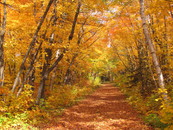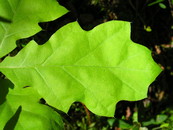|
Volume 6 - March 2021
Assisted Migration
Assisted Migration (AM) is becoming a popular topic when discussing and researching climate adaptation techniques, but this approach often leads to more questions than answers. In this issue, we summarize some of the latest AM research relevant to Minnesota, with a focus on trees. According to a research synthesis prepared by the Northern Institute of Applied Climate Science (NIACS), AM is any “human-assisted movement of species in response to climate change.” While many associate AM with the more transformative action of moving novel species into new areas, AM can include more subtle change. One example is moving seed sources or populations to new locations within or adjacent to the historical species range. A good place to start learning more about AM is the Climate Change Resource Center (CRCC), a national resource for natural resource professionals to learn more about climate change. The AM topic page on the CCRC includes a concise summary of the topic, definitions of different “types” of assisted migration, management considerations and links to relevant tools.
The Minnesota Research Reader is a collaboration between the Minnesota Department of Natural Resources and the U.S. Department of Agriculture Forest Service that provides a quick look at emerging research relevant to our work in the State of Minnesota. We hope you enjoy the selection of articles in this month's edition of the Reader!

This review, authored by Williams and Dumroese with the U.S. Forest Service Rocky Mountain Research Station, was published in the Journal of Forestry in 2013. This comprehensive review discusses uncertainties and risks associated with climate change and explores assisted migration as a management option. The article also offers resources that can help facilitate effective implementation of this management tactic.
Management Implications:
- Although plants have moved across the landscape in response to changing climate for millennia, projections of contemporary climate change suggest that forest tree species and populations will need to migrate faster than their natural ability.
- Lack of operating procedures, uncertainties about future climate conditions, risks associated with moving plants outside their current ranges, current seed transfer guidelines, and existing policies have hampered formal assisted migration efforts.
- Practical approaches to implementing assisted migration are offered, focusing on the topics of species selection, target migration distance, deployment strategies, and maintenance and monitoring.
|

This hot off the press study was published in 2020 in Diversity and Distributions by scientists from the U.S. Forest Service, Canadian Forest Service and School of Environment and Natural Resources (Columbus, Ohio). The study evaluated the current and future dynamics of 25 tree species spanning the United States and Canada to assess suitable climatic habitat under future climate change scenarios. Using 21 climatic variables under different emissions pathways, this study evaluates range-wide habitat suitability and colonization potential of tree species. At a continental scale, many species in the conterminous United States lose suitable climatic habitat but gain habitat in Canada and Alaska. For most species, even under optimistic migration rates, only a small portion of overall future suitable habitat is projected to be naturally colonized in ~100 years. Considerable variation among species points to the need for significant management efforts, including assisted migration, for economic or ecological reasons.
Management Implications:
- Featured tree species may require different conservation approaches in the United States (within-range conservation) and Canada (range expansion), thus requiring cross-border collaboration.
- Leading edge (northernly) habitats are projected to expand rapidly due to greater warming. Trailing-edge populations may remain viable, but subject to greater climatic stress.
- Within-range movements of climatically suitable genotypes represent a low-risk form of assisted migration that could help align population-level climate preferences with projected future climates.
|

This article, also from 2020 and authored by Minnesota scientists affiliated with the University of Minnesota - Duluth and The Nature Conservancy, appears in Ecological Applications. Warming in northern Minnesota over the last 100 years calls into question the long-term viability of many boreal tree species. The authors compared survival, growth and phenology of two oak species planted on sites in northern Minnesota sourced from two different ecotypes (northern vs. southern seed zones). They found that seedlings for southern ecotypes of both oak species had higher survival and growth than the northern ecotype. In addition, budburst occurred earlier for southern ecotypes, which also had thicker leaves that persisted longer into the fall.
Management Implications:
- It may be necessary to update statewide seed sourcing guidelines to allow flexibility for planting across seed zones—a form of assisted migration.
- It may be necessary to conduct provenance trials of Minnesota’s native tree species to develop species-specific guidelines for moving ecotypes northward or extending native ranges.
- It will become increasingly important to document seed collection locations and maintain detailed electronic records to track seedling performance by geographic origin as managers choose to move southern ecotypes northward.
|

Planting trees, to restore or sustain forest cover globally, is one of many strategies to combat the effects of climate change world-wide. Historically, forest managers planted species that existed in the forest and relied on local seed sources, but these practices may not hold into the future, as local species and seed sources may no longer be well-adapted to the planting site. Instead, forest managers may need to plant tree seedlings grown from more southerly seed sources to ensure that seedlings will survive and develop into vibrant forests. Nurseries will need to procure source-identified seed for their customers who are investing in tree plantings for future climates. Seed collection zones are commonly used for nurseries and seed collectors to track source-identification of seed and seedlings. The U.S. Forest Service devised a single set of seed collection zones for the entire Eastern United States (which includes Minnesota and the other Lake States) for managers, nurseries and seed collectors to track source identification of plant material across state lines. The results are published in the July 2020 Journal of Forestry.
Management Implications:
- The Eastern Seed collection zones were developed from a combination of plant hardiness zones and ecoregions, so all plants within a zone are adapted to a similar set of climatic conditions. Zones are snapped to county lines to ease identification of a seed source.
- Seeds collected from the adjacent southerly seed zone may be suitable for a planting site as a guide for assisted migration. The seed collection zones are relatively wide (east to west) and short (north to south), so movement of seed from adjacent zones is not likely to result in seed that is mismatched to the planting site.
- The Eastern Seed collection zones are relatively new, so be sure to plan and discuss your seed needs with your nursery before you attempt to purchase seedlings. The project map can be found at http://www.easternseedzones.com/
|
|